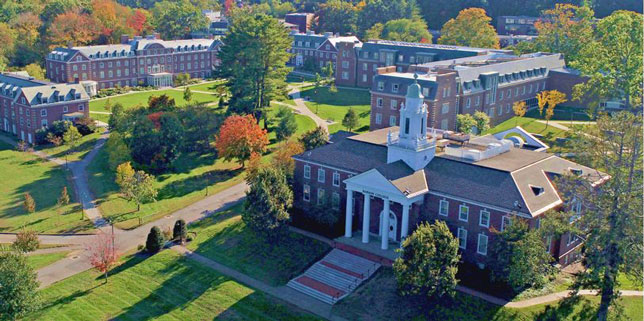3 Ways for IT to Prepare for Fall Classes
Babson College, like so many schools, is priming for the start of fall classes, which begin in just a few days. Here's how the Boston-based institution has positioned itself to succeed.
- By Dian Schaffhauser
- 08/13/20

Phillip Knutel
While the graduate school at Babson College long ago began catering to online students with hybrid courses for working professionals, the on-campus undergraduate experience was traditional in nature and very popular, according to CIO Phillip Knutel. "We have a beautiful campus and a beautiful gym, a beautiful library and beautiful residence halls. There are lots of things we have done to make this a terrific in-person experience." For undergraduates, online offerings were "really around the edges and not a core focus." That is, until COVID-19 arrived.
Suddenly, a typical semester with a "handful" of classes in online or blended format became 650 classes shifting entirely to a fully online model. "It was a mad scramble," recalled Knutel. "But we were fortunate to have a lot of the infrastructure and platforms and tools in place to do a fully online campus."
Now, the campus is getting ready to reopen. Most courses will be delivered in a hyflex model — where students may choose to be there in person or view the class remotely. Babson calls its version of this "webflex," which will give students the flexibility to move between face-to-face and online learning as needed throughout the semester. Three projects led by the IT organization have helped Babson prepare for whatever comes next.

Babson College
1) Daily Pulse Checks
Early on in the spring, Knutel set up "daily pulse checks" to see how students and faculty were faring. These were one-question surveys that showed up the moment somebody logged into the learning management system or the college's student or faculty portal. The survey used a zero-to-10 scale to find out how individual users were doing at the moment. A comment box collected feedback on the details.
Then IT built a dashboard in Salesforce to pull in the metrics that were most useful, said Knutel.
The pulse check allowed students to express small problems and large. On the small side, Knutel noted, were issues with connectivity, audio, video and other platform ailments. With those, IT could quickly "make changes and get messages back to the students, saying, 'Here's what we heard — this is what we've done.'"
Then there were the larger issues. On the upside, students said that Babson had done a "good job" of working with faculty in helping them understand how to teach online, digitize materials and convert physical activities into viable online versions.
On the downside, students felt they were being assigned even more work by their instructors than if they'd been attending classes in person. "Even though the workload for an entirely digital experience may have been incremental at the individual course level, at the macro level for a student taking four, five or six classes, it turned into a dramatic increase in the workload in the eyes of the students," explained Knutel. "They were dealing with being at home; not having a quiet place like a library to work in; having the distractions of family, friends, siblings, pets; maybe not great internet connectivity or great bandwidth. They had enough going on in terms of what had just uprooted their very popular campus experience at Babson to this very fully online experience."
In response, the college switched to a pass-fail option, to remove a layer of stress from students over how they could keep up their grade point averages.
The daily pulse checks ended when "we saw significant drop-off" near the end of the semester, said Knutel. He was also concerned not to "burn out the students [with it] being up all the time." If it looks like it would be useful for the fall, he added, he'll bring it back.
2) Portable Classroom Setups
It's doubtful that any of Babson's classes will be 100 percent in-person, said Knutel. The college has already invested a few million dollars in faculty development, hardware and software as part of a "de-densification strategy" to improve the learning experience and make sure its classrooms will be ready, he noted. While a lot of the smaller classrooms on campus will end up being empty for much of the fall, the mid-sized and larger classrooms will be "booked pretty solid."
The classrooms have been equipped with advanced microphones and cameras that automatically pivot to, and zoom in on, the person speaking, whether in the room or online. As Knutel described, those AV components "will lock onto the professor's voice, and if he or she wanders throughout the space, the cameras will follow through the room and the mics will pick up students' voices as students speak up and ask questions." There will also be "confidence monitors" in the room so that the faculty member who's looking out at the physical students in the classroom "will see a large display that shows the webcams from the online students, so [he or she] can more easily and seamlessly call on students."
And then there are the larger meeting spaces that will be converted to classrooms at least temporarily. Rather than outfitting them permanently with tech that might be in use for only one or two semesters, the school will install portable equipment. "The camera could be on a tripod set up a few feet from the podium at the front of the room, and microphones and speakers will be spread throughout the room to try to capture faculty and student audio," said Knutel.
In both kinds of settings, Cisco WebEx will serve as a virtual classroom meeting space. That's an application that Babson has been using for two decades, which means a lot of faculty had already been trained and "were pretty facile with it." When the campus shut down, those were the instructors Babson turned to "to train the rest of the faculty," Knutel said.
The goal in both kinds of classrooms — the permanent ones and the temporary ones — is to make the technology "as user friendly and as self-sufficient as possible." The faculty member should be able to go in and turn the room "on." The cameras will "find" the faculty member and follow them; and the microphones and ceiling speakers will start working. All the instructors have to do is "pay attention to the WebEx interface on the main screen in front of the room."
3) Adapting Team Projects
Babson has long been known for its team orientation in classes. Students work together on numerous projects during their college career. And that "will be a big part of what we continue to support," said Knutel.
That has meant that a lot of faculty have had to adapt their course materials, he added. In a hyflex environment, that means instructors will probably have teams that either divvy up physically by who's present versus who's online, or with a mix — "two students on campus and two online students in each team."
The school has also expedited rollout of Cisco WebEx Teams, a deployment that was just getting started when coronavirus closed the campus. This is a version of WebEx that includes extra collaboration functionality. Anybody on the team can be the host and start meetings, share screens, mute each other and record the session. The software also includes features for chat, secure group messaging, whiteboard work, scheduling and storage of files through several cloud-based sharing services.
In pilots, WebEx Teams "has gotten great traction, and we've seen some great anecdotes about how much people find it useful," said Knutel.
Of course, nobody thinks that the students who signed on for a "Babson experience" were really signing on "for a 100-percent online experience," Knutel acknowledged. "We'd love to have them back on campus."
At the same time, Babson has exploited the opportunities too. "We've been able to accelerate what was going to be a part of our online strategy much more quickly than we ever could have imagined," he said. "And now I think the market will be expecting more in this realm. That's not to say, by the way, there isn't a place for an on-campus experience and education. Time will tell as to whether students vote with their feet and decide to leave campus if this is not an experience that they are finding beneficial. My sense is that they're going be thrilled to be back and being in a room insofar as it's possible."